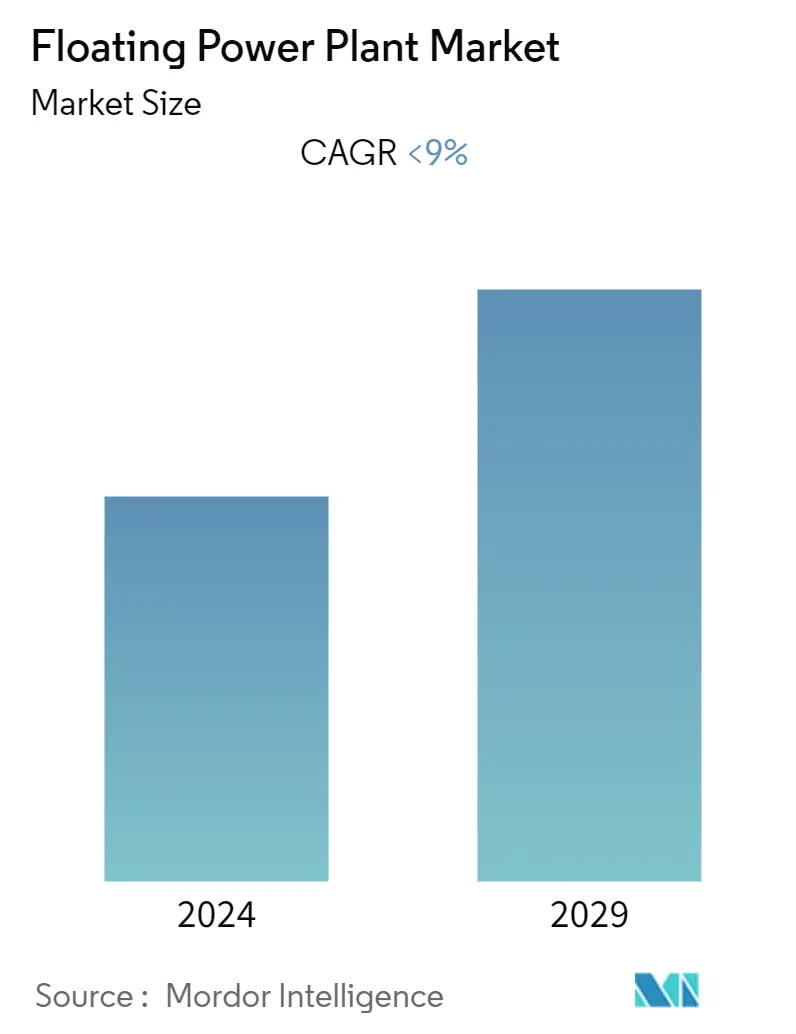Market Size of Floating Power Plant Industry

| Study Period | 2020 - 2029 |
| Base Year For Estimation | 2023 |
| CAGR | 9.00 % |
| Fastest Growing Market | Asia Pacific |
| Largest Market | Europe |
| Market Concentration | High |
Major Players
*Disclaimer: Major Players sorted in no particular order |
Floating Power Plant Market Analysis
The floating power plant market is expected to rise at a CAGR of approximately 9% during the forecast period of 2020-2025. Factors such as ability electricity generation in the areas which have limited infrastructure and the ability of the plant to be transported and provide rapid demand for power at specific locations are likely to drive the floating power plant market. However, rough weather conditions such as cyclones and tsunami, which destabilize the floating structures, are expected to restrain the floating power plant market.
- The renewable segment, due to its ability to produce clean energy, have impact on the world's changing environmental conditions, is expected to be the largest segment in the floating power plant market.
- The development of technologies such as automation and digitalization in the floating power sector is going to decrease the operational cost of the plants and also reduce the human accidents on site, which is likely to create several opportunities for the floating power plant market in the future.
- Europe held a significant market share and is expected to dominate the market during the forecast period. As of 2019, there are 13 announced offshore floating wind projects globally out of which 9 are in Europe region.
Floating Power Plant Industry Segmentation
The floating power plant market report include:
| Source | ||||
| ||||
|
| Geography | |
| North America | |
| Europe | |
| Asia-Pacific | |
| South America | |
| Middle-East and Africa |
Floating Power Plant Market Size Summary
The floating power plant market is poised for significant growth, driven by its ability to generate electricity in areas with limited infrastructure and its transportability to meet rapid power demands. Despite challenges posed by adverse weather conditions that can destabilize floating structures, the market is expected to expand, with the renewable energy segment leading due to its environmental benefits. Technological advancements in automation and digitalization are anticipated to reduce operational costs and enhance safety, creating new opportunities within the sector. Europe is expected to maintain a dominant position in the market, supported by substantial investments and a focus on cleaner energy solutions.
Floating renewable energy installations, primarily utilizing solar and wind technologies, offer a viable solution for regions with limited land availability. These installations are particularly beneficial in areas with high energy demands and minimal pollution impact. The market has attracted global investors, recognizing the potential of floating power plants for renewable energy generation. European countries have been proactive in exploring new electricity generation methods, aligning with EU targets for cleaner energy and reduced fossil fuel dependency. This strategic focus, along with significant investments in projects like the Erebus floating wind farm, underscores Europe's leadership in the floating power plant market. The market is moderately consolidated, with key players including Ciel & Terre International, Kawasaki Heavy Industries Ltd, Wartsila Oyj Abp, Equinor ASA, and Karadeniz Holding.
Floating Power Plant Market Size - Table of Contents
-
1. MARKET OVERVIEW
-
1.1 Introduction
-
1.2 Floating Power Plant Installation Capacity Forecast, in Megawatts (MW), till 2025
-
1.3 Recent Trends and Developments
-
1.4 Government Policies and Regulations
-
1.5 Market Dynamics
-
1.5.1 Drivers
-
1.5.2 Restraints
-
-
1.6 Supply Chain Analysis
-
1.7 Porter's Five Force Analysis
-
1.7.1 Bargaining Power of Suppliers
-
1.7.2 Bargaining Power of Consumers
-
1.7.3 Threat of New Entrants
-
1.7.4 Threat of Substitutes Products and Services
-
1.7.5 Intensity of Competitive Rivalry
-
-
-
2. MARKET SEGMENTATION
-
2.1 Source
-
2.1.1 Renewable
-
2.1.1.1 Solar
-
2.1.1.2 Wind
-
-
2.1.2 Non-Renewable
-
2.1.2.1 Gas Engines
-
2.1.2.2 IC Engines
-
-
-
2.2 Geography
-
2.2.1 North America
-
2.2.2 Europe
-
2.2.3 Asia-Pacific
-
2.2.4 South America
-
2.2.5 Middle-East and Africa
-
-
Floating Power Plant Market Size FAQs
What is the current Floating Power Plant Market size?
The Floating Power Plant Market is projected to register a CAGR of less than 9% during the forecast period (2024-2029)
Who are the key players in Floating Power Plant Market?
Ciel & Terre international, Wartsila Oyj Abp and Equinor ASA. are the major companies operating in the Floating Power Plant Market.

